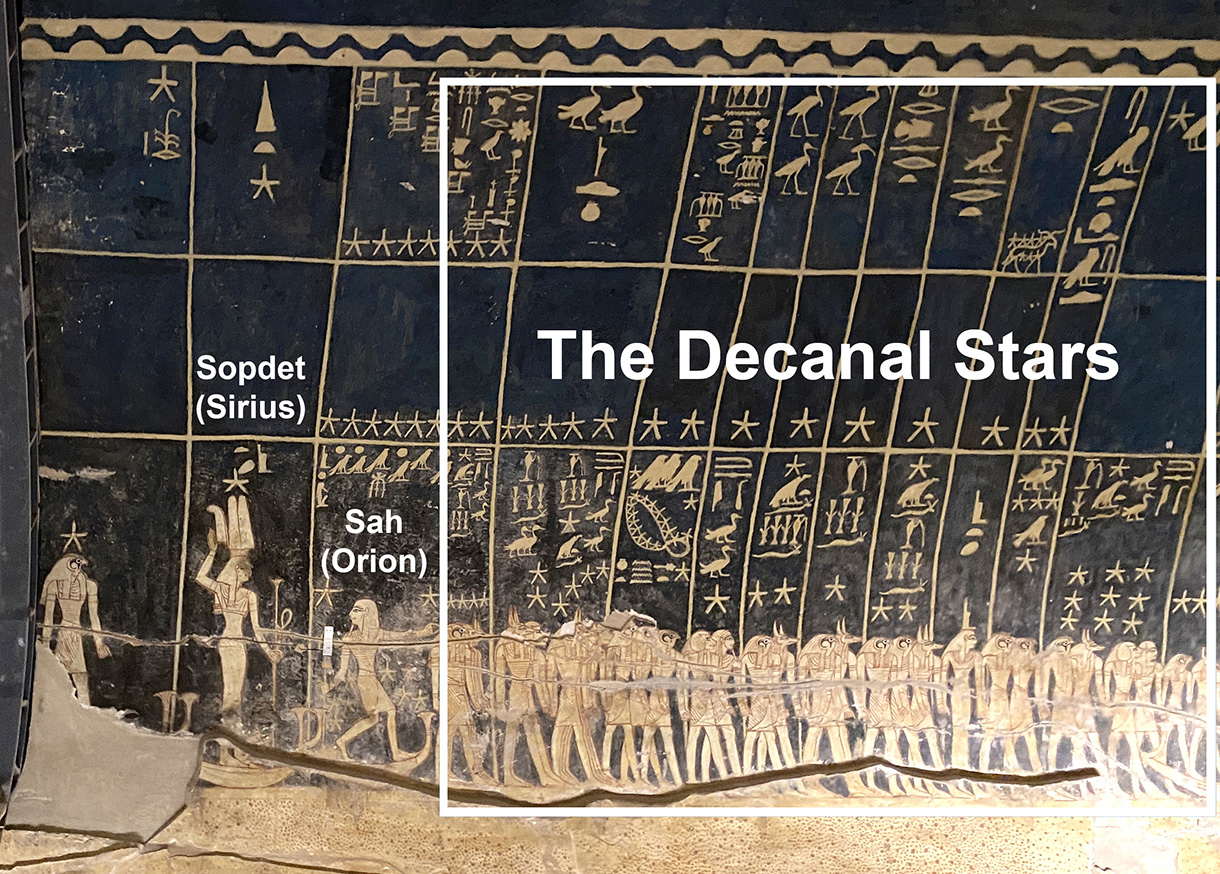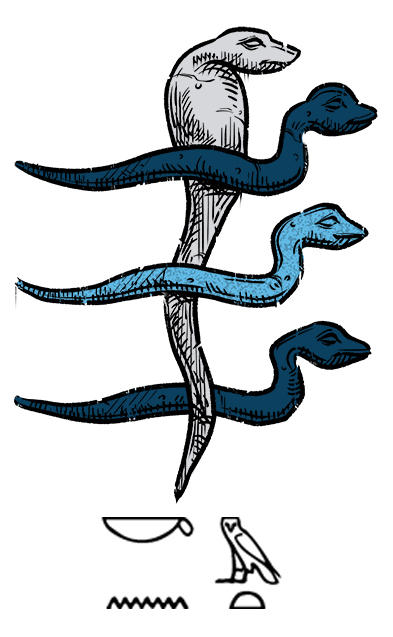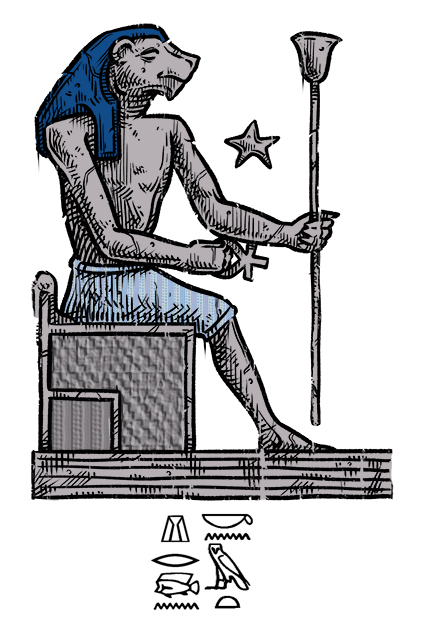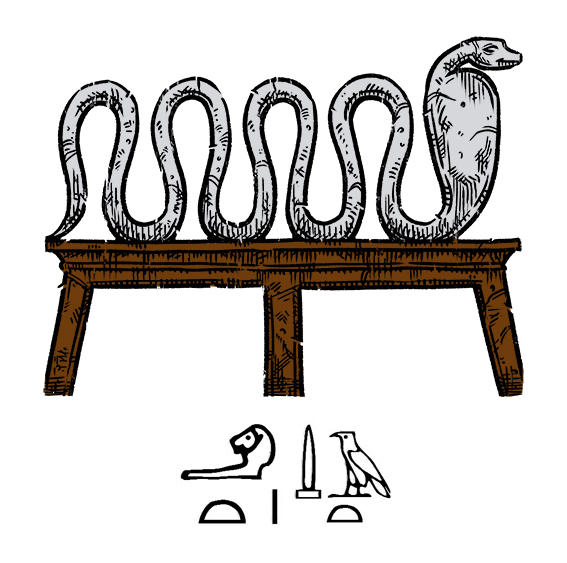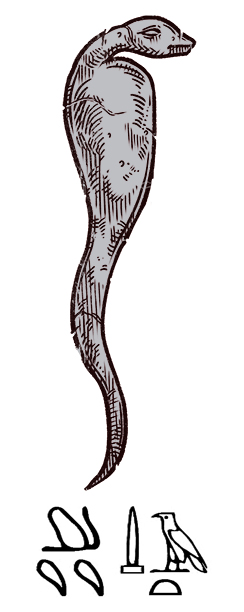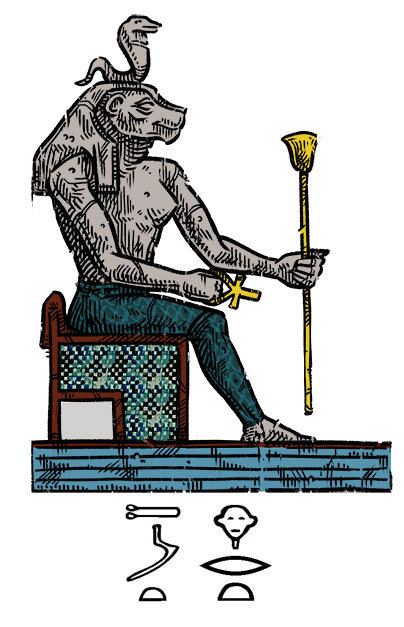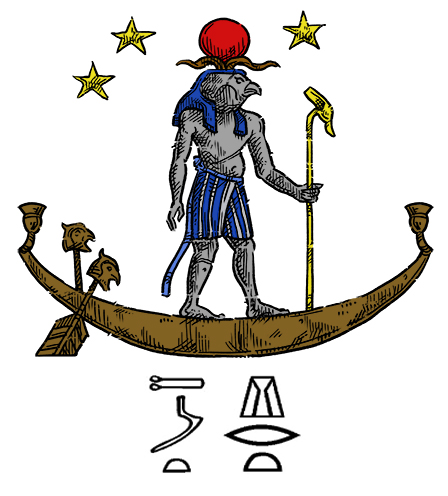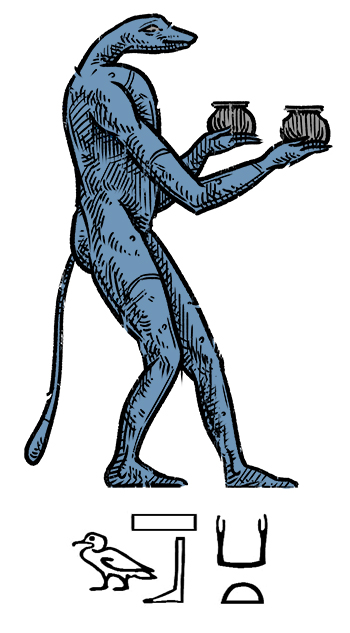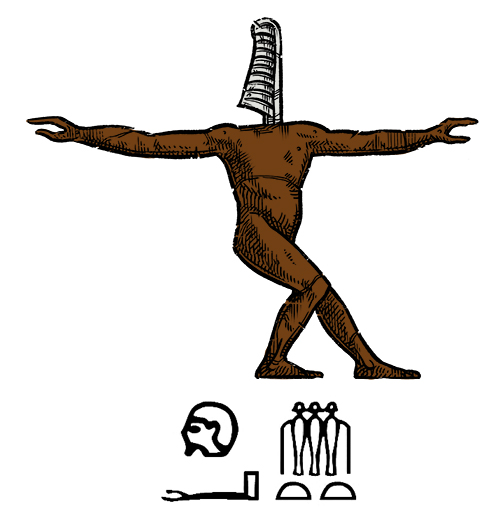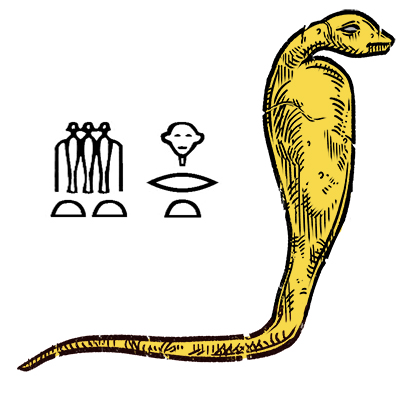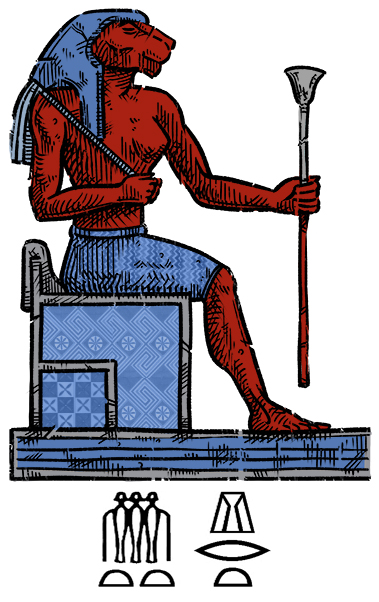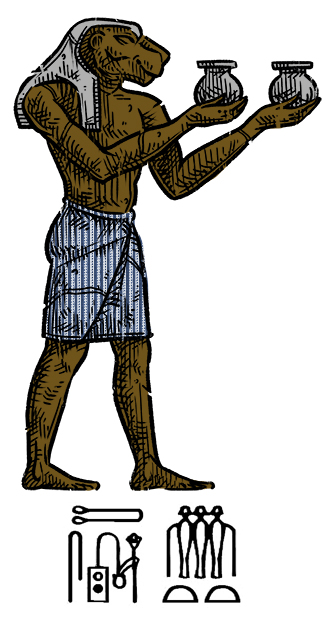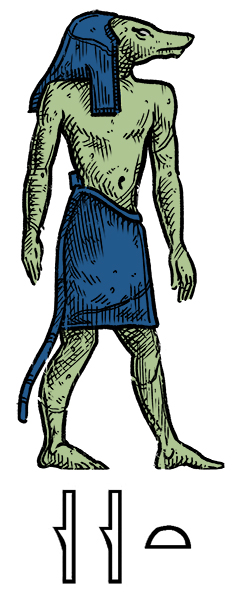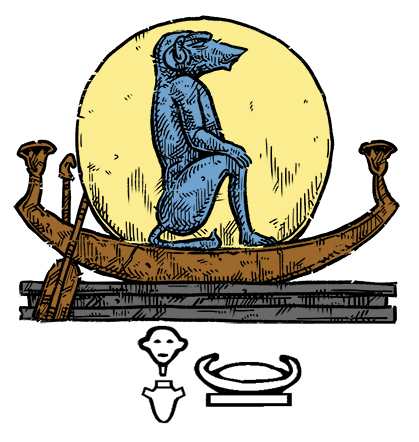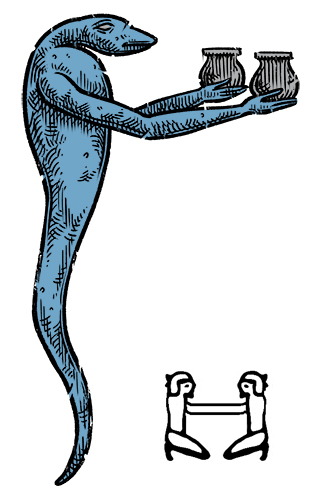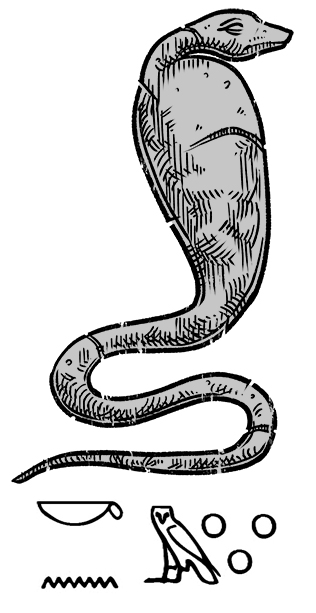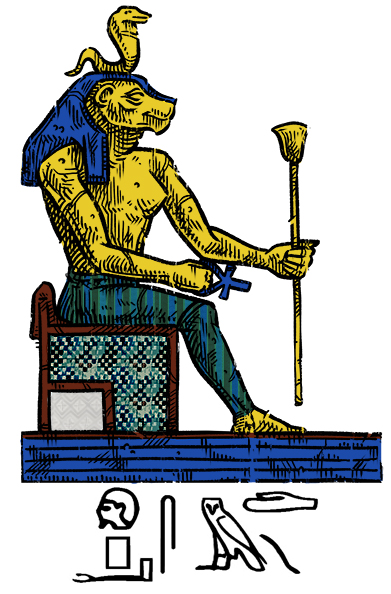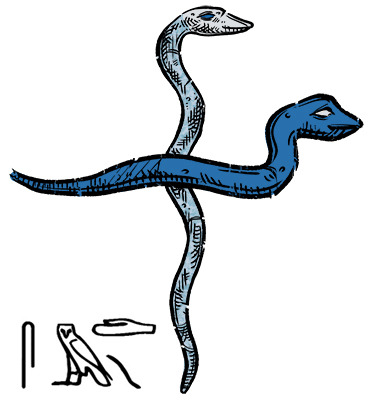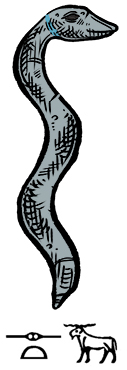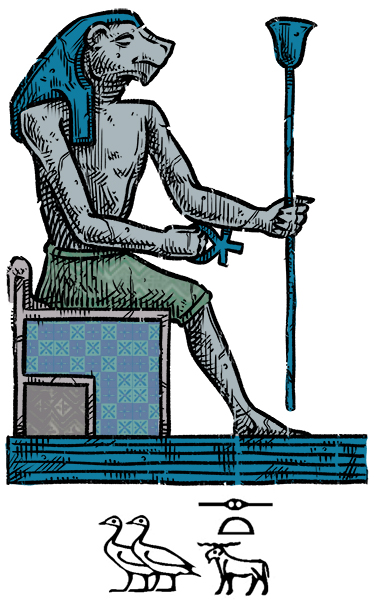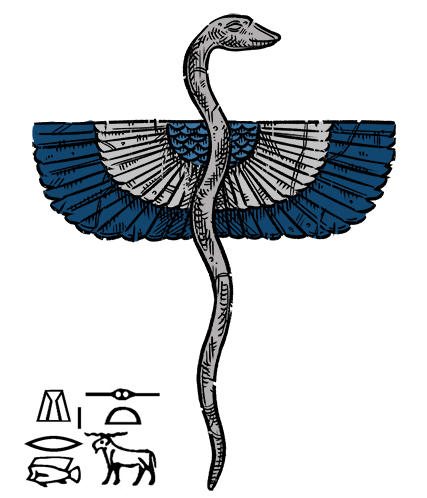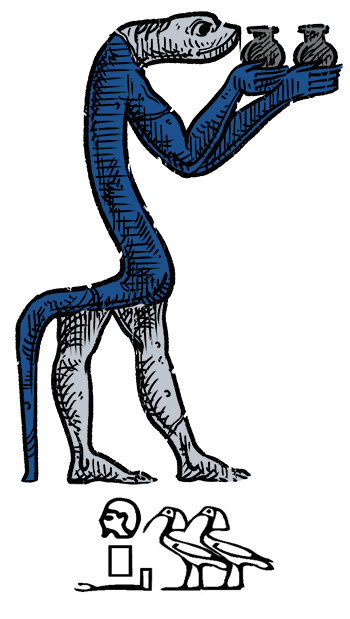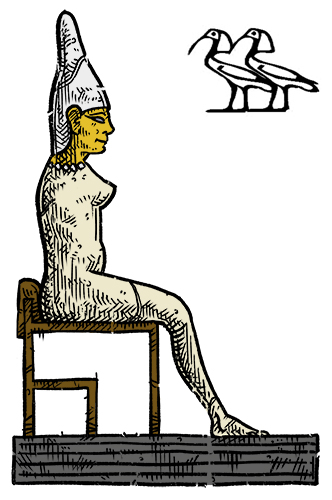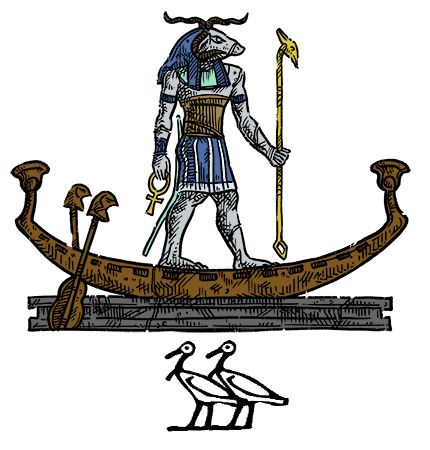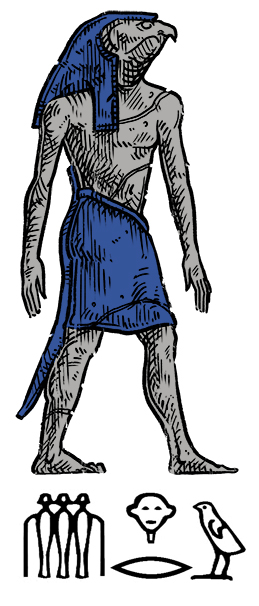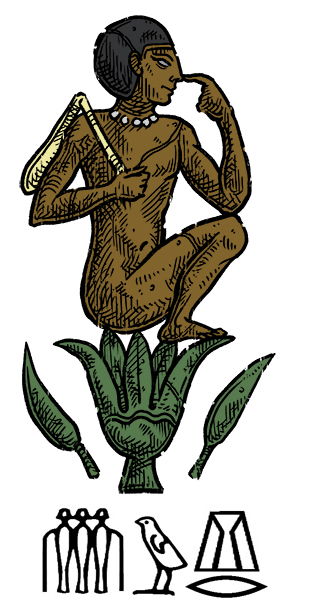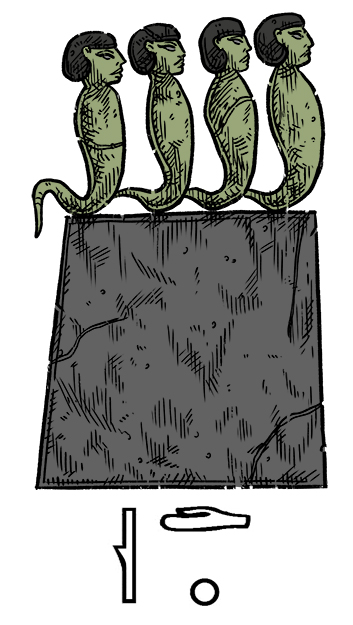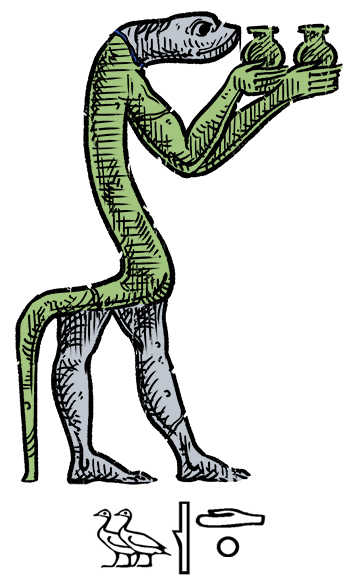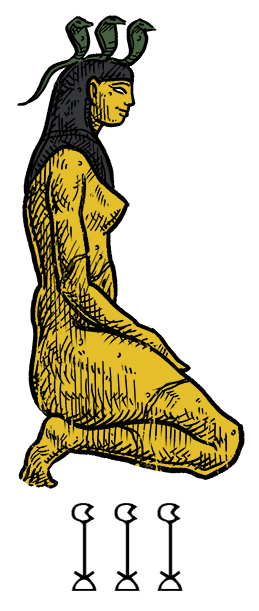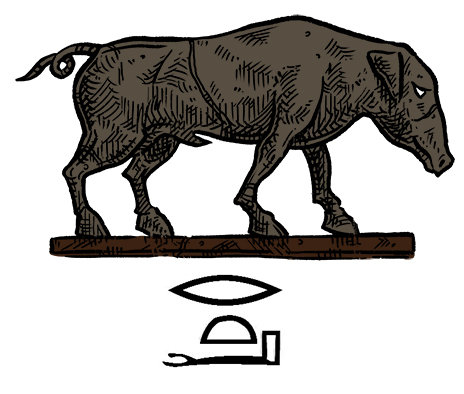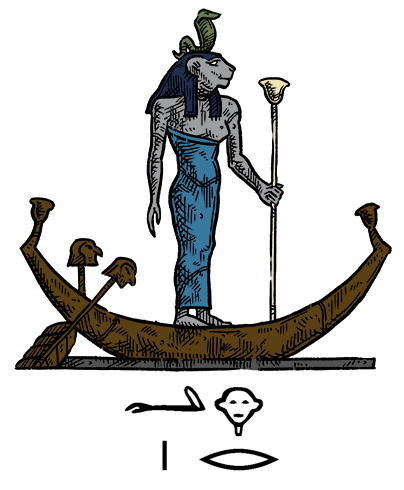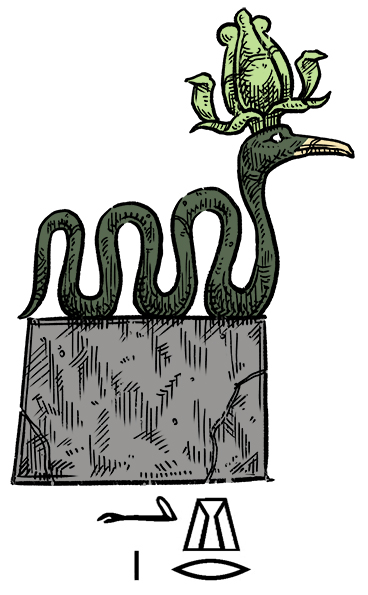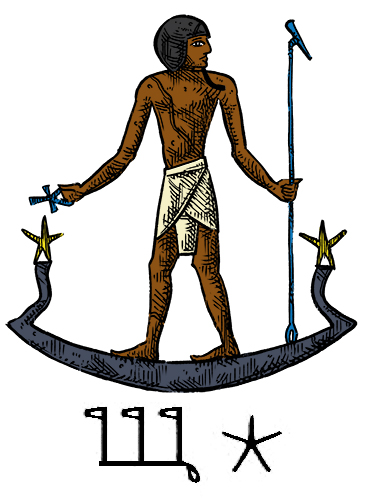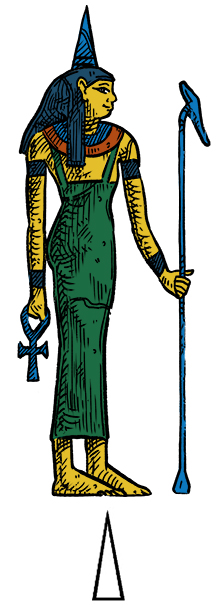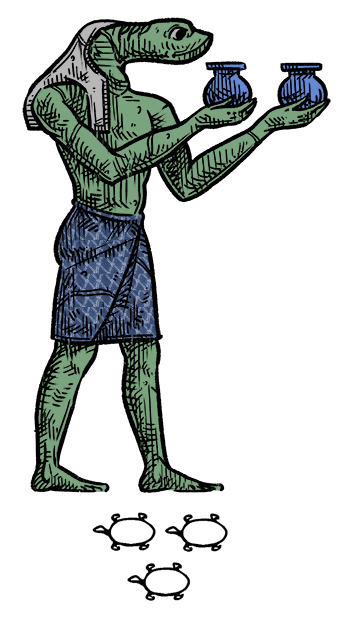Difference between revisions of "Egyptian decans"
Occultwiki (talk | contribs) |
Occultwiki (talk | contribs) |
||
| (8 intermediate revisions by the same user not shown) | |||
| Line 8: | Line 8: | ||
==History== | ==History== | ||
Decans first appeared in the 10th Dynasty (2100 BCE) on coffin lids found in tombs of noblemen in the region of Asyut. The sequence of these star patterns began with [[Sopdet]], the star [[Sirius]], and each decanal star had a corresponding deity. As measures of time, the rising and setting of decans marked 'hours' and groups of 10 days which comprised an Egyptian year. The ancient [[ | Decans first appeared in the 10th Dynasty (2100 BCE) on coffin lids found in tombs of noblemen in the region of Asyut. The sequence of these star patterns began with [[Sopdet]], the star [[Sirius]], and each decanal star had a corresponding deity. As measures of time, the rising and setting of decans marked 'hours' and groups of 10 days which comprised an Egyptian year. The ancient Book of [[Nut]] covers the subject of the decans. | ||
After Alexander the Great invaded Egypt, Egyptian astrology melded with Greek and Persian astrology and the original system of decans gave way to a lunar division of 27 or 28 lunar stations, also known as ''manzil'' | After Alexander the Great invaded Egypt, [[Egyptian astrology]] melded with Greek and Persian astrology and the original system of decans gave way to a lunar division of 27 or 28 lunar stations, also known as ''manzil'' ([[lunar mansion]]s) and to a [[zodiac]] of 12 signs, based on an anthropomorphic pattern of constellations, and their use can be seen in the Dendera zodiac dated to circa 50 BCE. | ||
Decans continued to be used in [[astrology]] in medieval Islam, Renaissance, 17-century astrology, 19-century Theosophy, and in cosmology, theurgy, and hermeticism, as well as in religion and magic. | Decans continued to be used in [[astrology]] in medieval [[Islam]], Renaissance, 17-century [[astrology]], 19-century [[Theosophy]], and in cosmology, theurgy, and hermeticism, as well as in religion and [[ritual magic]]. | ||
In 2021, [[occultist]] [[Travis McHenry]] created a system of [[divination]] based on the Egyptian decans. He incorporated this system into a deck of cards called [[The Egyptian Star Oracle]]. | In 2021, [[occultist]] [[Travis McHenry]] created a system of [[divination]] based on the Egyptian decans. He incorporated this system into a deck of cards called [[The Egyptian Star Oracle]]. | ||
==Number of decans== | ==Number of decans== | ||
Although it is commonly believed that there are only 36 decans, in fact, there are around 100 decanal stars, although only 36 were used in the course of any given Egyptian year. The reason for the large number of stars has to do with the Sothic shift and the fact that the 365-day cycle of the star Sirius does not perfectly align with earth's 365.25-day solar cycle. To compensate for this minor variation, the Egyptians allowed for subtle shifts in the decanal stars they used throughout the year. | Although it is commonly believed that there are only 36 decans, in fact, there are around 100 decanal stars, although only 36 were used in the course of any given Egyptian year. The reason for the large number of stars has to do with the Sothic shift and the fact that the 365-day cycle of the star [[Sirius]] does not perfectly align with earth's 365.25-day solar cycle. To compensate for this minor variation, the Egyptians allowed for subtle shifts in the decanal stars they used throughout the year. | ||
Additionally, five days were added to the end of the Egyptian | Additionally, five days were added to the end of the [[Egyptian calendar]] each year, and these days had their own decan in addition to have a specific deity rule over each individual day. | ||
==Identity of the decans== | ==Identity of the decans== | ||
| Line 30: | Line 30: | ||
==List of decans== | ==List of decans== | ||
This is a list of the 37 decans that were most commonly used across a broad time period from 2100 BC until the demise of the Egyptian religion in 356 AD, owing to the [[Religious policies of Constantius II|religious policies of Roman Emperor Constantius II]]. The order presented here represents the order in which each star's heliacal rise occurs over the course of the | This is a list of the 37 decans that were most commonly used across a broad time period from 2100 BC until the demise of the Egyptian religion in 356 AD, owing to the [[Religious policies of Constantius II|religious policies of Roman Emperor Constantius II]]. The order presented here represents the order in which each star's heliacal rise occurs over the course of the [[Egyptian calendar]]. The end of the year coincided with the rise of [[Sirius]], followed by the five epagomenal days, after which the cycle would start again with the rise of [[Tepy-a Kenmet]] on I Akhet 1 at the beginning of a new year. | ||
{| class="wikitable" | {| class="wikitable" | ||
!'''Decade''' | !'''Decade''' | ||
!'''Image''' | |||
!'''Transliteration''' | !'''Transliteration''' | ||
!'''Translation''' | !'''Translation''' | ||
| Line 41: | Line 42: | ||
|- | |- | ||
|1 | |1 | ||
|[[File:01-Tpya Knmt.jpg|100px|center]] | |||
|[[Tepy-a Kenmet]] | |[[Tepy-a Kenmet]] | ||
|Predecessor of the Cow | |Predecessor of the Cow | ||
| Line 48: | Line 50: | ||
|- | |- | ||
|2 | |2 | ||
|[[File:02-Knmt.jpg|100px|center]] | |||
|[[Kenmet]] | |[[Kenmet]] | ||
|The Cow | |The Cow | ||
| Line 55: | Line 58: | ||
|- | |- | ||
|3 | |3 | ||
|[[File:03-hry hpd knmt.jpg|100px|center]] | |||
|[[Khery Heped En Kenmet]] | |[[Khery Heped En Kenmet]] | ||
|Under the Hind Part of the Cow | |Under the Hind Part of the Cow | ||
| Line 62: | Line 66: | ||
|- | |- | ||
|4 | |4 | ||
|[[File:04-Hat Dat.jpg|100px|center]] | |||
|[[Hat Djat]] | |[[Hat Djat]] | ||
|Beginning of the Crane | |Beginning of the Crane | ||
| Line 69: | Line 74: | ||
|- | |- | ||
|5 | |5 | ||
|[[File:05-Phwy Dat.jpg|100px|center]] | |||
|[[Pehuy Djat]] | |[[Pehuy Djat]] | ||
|End of the Crane | |End of the Crane | ||
|Accomplishment | |Accomplishment | ||
|Crane | |Crane | ||
|Galena and Gold | |[[Galena]] and Gold | ||
|- | |- | ||
|6 | |6 | ||
|[[File:06-Tmat Hrt.jpg|100px|center]] | |||
|[[Temat Heret]] | |[[Temat Heret]] | ||
|Upper Wing | |Upper Wing | ||
| Line 83: | Line 90: | ||
|- | |- | ||
|7 | |7 | ||
|[[File:7-Tmat.jpg|100px|center]] | |||
|[[Temat Kheret]] | |[[Temat Kheret]] | ||
|Lower Wing | |Lower Wing | ||
| Line 90: | Line 98: | ||
|- | |- | ||
|8 | |8 | ||
|[[File:08-Wsati Bkati.jpg|100px|center]] | |||
|[[Weshati Bekati]] | |[[Weshati Bekati]] | ||
|The Pregnant Twins | |The Pregnant Twins | ||
| Line 97: | Line 106: | ||
|- | |- | ||
|9 | |9 | ||
|[[File:09-Ip-djes.jpg|100px|center]] | |||
|[[Ip-Djes]] | |[[Ip-Djes]] | ||
|Recovered Senses | |Recovered Senses | ||
| Line 104: | Line 114: | ||
|- | |- | ||
|10 | |10 | ||
|[[File:10-Tpya Hntt.jpg|100px|center]] | |||
|[[Tepy-a Khentet]] | |[[Tepy-a Khentet]] | ||
|Predecessor of Khentet | |Predecessor of Khentet | ||
| Line 111: | Line 122: | ||
|- | |- | ||
|11 | |11 | ||
|[[File:11-Hntt Hrt.jpg|100px|center]] | |||
|[[Khentet heret]] | |[[Khentet heret]] | ||
|Upper Khentet | |Upper Khentet | ||
| Line 118: | Line 130: | ||
|- | |- | ||
|12 | |12 | ||
|[[File:12-Hntt Xrt.jpg|100px|center]] | |||
|[[Khentet kheret]] | |[[Khentet kheret]] | ||
|Lower Khentet | |Lower Khentet | ||
| Line 124: | Line 137: | ||
|Red [[Jasper]] and Gold | |Red [[Jasper]] and Gold | ||
|- | |- | ||
|13 | |[[13 (number)|13]] | ||
|[[File:13-Tms n hntt.jpg|100px|center]] | |||
|[[Tjemes en Khentet]] | |[[Tjemes en Khentet]] | ||
|Red one of Khentet | |Red one of Khentet | ||
| Line 132: | Line 146: | ||
|- | |- | ||
|14 | |14 | ||
|[[File:14-Qedty.jpg|100px|center]] | |||
|[[Qedty]] | |[[Qedty]] | ||
|Band of Reeds | |Band of Reeds | ||
| Line 139: | Line 154: | ||
|- | |- | ||
|15 | |15 | ||
|[[File:15-Hnry-wiba.jpg|100px|center]] | |||
|[[Hery-ib Wia]] | |[[Hery-ib Wia]] | ||
|Middle of the Boat | |Middle of the Boat | ||
| Line 146: | Line 162: | ||
|- | |- | ||
|16 | |16 | ||
|[[File:16 -Ssmw.jpg|100px|center]] | |||
|[[Seshmu]] | |[[Seshmu]] | ||
|Guides or Winepress | |Guides or Winepress | ||
| Line 153: | Line 170: | ||
|- | |- | ||
|17 | |17 | ||
|[[File:17-Knmw.jpg|100px|center]] | |||
|[[Kenmu]] | |[[Kenmu]] | ||
|Secret Stars | |Secret Stars | ||
| Line 160: | Line 178: | ||
|- | |- | ||
|18 | |18 | ||
|[[File:18-Tpya Smd.jpg|100px|center]] | |||
|[[Tepy-a Semed]] | |[[Tepy-a Semed]] | ||
|Predecessor of the Horn | |Predecessor of the Horn | ||
| Line 167: | Line 186: | ||
|- | |- | ||
|19 | |19 | ||
|[[File:19 Smd.jpg|100px|center]] | |||
|[[Semed]] | |[[Semed]] | ||
|The Horn | |The Horn | ||
| Line 174: | Line 194: | ||
|- | |- | ||
|20 | |20 | ||
|[[File:20-srt.jpg|100px|center]] | |||
|[[Seret]] | |[[Seret]] | ||
|The Sheep | |The Sheep | ||
| Line 181: | Line 202: | ||
|- | |- | ||
|21 | |21 | ||
|[[File:21-Sawy Srt.jpg|100px|center]] | |||
|[[Sawy Seret]] | |[[Sawy Seret]] | ||
|Children of the Sheep | |Children of the Sheep | ||
| Line 188: | Line 210: | ||
|- | |- | ||
|22 | |22 | ||
|[[File:22-Hry Hpd srt.jpg|100px|center]] | |||
|[[Khery Heped Seret]] | |[[Khery Heped Seret]] | ||
|Under the Hind Part of the Sheep | |Under the Hind Part of the Sheep | ||
| Line 195: | Line 218: | ||
|- | |- | ||
|23 | |23 | ||
|[[File:23-Tpya Awhy.jpg|100px|center]] | |||
|[[Tepy-a Akhuy]] | |[[Tepy-a Akhuy]] | ||
|Predecessor of the Two Spirits | |Predecessor of the Two Spirits | ||
| Line 202: | Line 226: | ||
|- | |- | ||
|24 | |24 | ||
|[[File:24-Ahwy.jpg|100px|center]] | |||
|[[Akhuy]] | |[[Akhuy]] | ||
|The Two Spirits | |The Two Spirits | ||
| Line 209: | Line 234: | ||
|- | |- | ||
|25 | |25 | ||
|[[File:25-Bawy.jpg|100px|center]] | |||
|[[Bawy]] | |[[Bawy]] | ||
|The Two Souls | |The Two Souls | ||
| Line 216: | Line 242: | ||
|- | |- | ||
|26 | |26 | ||
|[[File:26-Hntw Hrw.jpg|100px|center]] | |||
|[[Khentu Heru]] | |[[Khentu Heru]] | ||
|Upper Khentu | |Upper Khentu | ||
| Line 223: | Line 250: | ||
|- | |- | ||
|27 | |27 | ||
|[[File:27-Hntw Hrw.jpg|100px|center]] | |||
|[[Khentu Kheru]] | |[[Khentu Kheru]] | ||
|Lower Khentu | |Lower Khentu | ||
| Line 230: | Line 258: | ||
|- | |- | ||
|28 | |28 | ||
|[[File:28-Qed.jpg|100px|center]] | |||
|[[Qed]] | |[[Qed]] | ||
|The Potter | |The Potter | ||
| Line 237: | Line 266: | ||
|- | |- | ||
|29 | |29 | ||
|[[File:29-Sawy Qed.jpg|100px|center]] | |||
|[[Sawy Qed]] | |[[Sawy Qed]] | ||
|Children of the Potter | |Children of the Potter | ||
| Line 244: | Line 274: | ||
|- | |- | ||
|30 | |30 | ||
|[[File:30-Haw.jpg|100px|center]] | |||
|[[Khau]] | |[[Khau]] | ||
|Thousands | |Thousands | ||
| Line 251: | Line 282: | ||
|- | |- | ||
|31 | |31 | ||
|[[File:31-Art.jpg|100px|center]] | |||
|[[Aryt]] | |[[Aryt]] | ||
|Roll of Papyrus | |Roll of Papyrus | ||
| Line 258: | Line 290: | ||
|- | |- | ||
|32 | |32 | ||
|[[File:32-Rm hrny sah.jpg|100px|center]] | |||
|[[Remen Hery Sah]] | |[[Remen Hery Sah]] | ||
|Upper arm of Sah | |Upper arm of Sah | ||
| Line 265: | Line 298: | ||
|- | |- | ||
|33 | |33 | ||
|[[File:33-Rmn Khry Sah.jpg|100px|center]] | |||
|[[Remen Khery Sah]] | |[[Remen Khery Sah]] | ||
|Lower arm of Sah | |Lower arm of Sah | ||
| Line 272: | Line 306: | ||
|- | |- | ||
|34 | |34 | ||
|[[File:34-Sah.jpg|100px|center]] | |||
|[[Sah]] | |[[Sah]] | ||
|The Father of the Gods | |The Father of the Gods | ||
| Line 279: | Line 314: | ||
|- | |- | ||
|35 | |35 | ||
|[[File:35-Tpya-Sopdet.jpg|100px|center]] | |||
|[[Tepy-a Sopdet]] | |[[Tepy-a Sopdet]] | ||
|Predecessor of Sopdet | |Predecessor of Sopdet | ||
| Line 286: | Line 322: | ||
|- | |- | ||
|36 | |36 | ||
|[[File:36-Sopdet.jpg|100px|center]] | |||
|[[Sopdet]] | |[[Sopdet]] | ||
|Goddess of the Flood | |Goddess of the Flood | ||
| Line 293: | Line 330: | ||
|- | |- | ||
|37 | |37 | ||
|[[File:37 Stwy.jpg|100px|center]] | |||
|[[Shetwy]] | |[[Shetwy]] | ||
|The Two Tortoises | |The Two Tortoises | ||
Latest revision as of 15:55, 13 November 2024
The Egyptian decans are a series of stars or small groups of stars used in ancient Egyptian astrology. These stars were worshipped as part of Egyptian religious practices.
Motion
The decans each appear to rise consecutively on the horizon throughout each daily earth rotation. The rising of each decan marked the beginning of a new decanal "hour" (Greek hōra) of the night, and they were used as a sidereal star clock beginning by at least the 9th or 10th Dynasty (2100 BCE).
Because a new decan appears heliacally every ten days, thus marking the start of a new 10 day week in the Egyptian calendar, the ancient Greeks called them dekanoi (δεκανοί; pl. of δεκανός dekanos) meaning "tenths".
History
Decans first appeared in the 10th Dynasty (2100 BCE) on coffin lids found in tombs of noblemen in the region of Asyut. The sequence of these star patterns began with Sopdet, the star Sirius, and each decanal star had a corresponding deity. As measures of time, the rising and setting of decans marked 'hours' and groups of 10 days which comprised an Egyptian year. The ancient Book of Nut covers the subject of the decans.
After Alexander the Great invaded Egypt, Egyptian astrology melded with Greek and Persian astrology and the original system of decans gave way to a lunar division of 27 or 28 lunar stations, also known as manzil (lunar mansions) and to a zodiac of 12 signs, based on an anthropomorphic pattern of constellations, and their use can be seen in the Dendera zodiac dated to circa 50 BCE.
Decans continued to be used in astrology in medieval Islam, Renaissance, 17-century astrology, 19-century Theosophy, and in cosmology, theurgy, and hermeticism, as well as in religion and ritual magic.
In 2021, occultist Travis McHenry created a system of divination based on the Egyptian decans. He incorporated this system into a deck of cards called The Egyptian Star Oracle.
Number of decans
Although it is commonly believed that there are only 36 decans, in fact, there are around 100 decanal stars, although only 36 were used in the course of any given Egyptian year. The reason for the large number of stars has to do with the Sothic shift and the fact that the 365-day cycle of the star Sirius does not perfectly align with earth's 365.25-day solar cycle. To compensate for this minor variation, the Egyptians allowed for subtle shifts in the decanal stars they used throughout the year.
Additionally, five days were added to the end of the Egyptian calendar each year, and these days had their own decan in addition to have a specific deity rule over each individual day.
Identity of the decans
Studying the decans in a practical sense is complicated because the actual stars that were observed by the Egyptians and regarded as decans are mostly not known. Many scientists have attempted to determine which stars might be decans, but these theories have failed to gain broad support from their peers. Some decans have been conclusively identified. In his 2022 book, Cult of the Stars, Travis McHenry states that without further sources being revealed from the Middle Kingdom Period, the stellar identities of the decans are likely to remain unknown; however, he also proposes that a few decans can be identified with a high degree of certainty:
- Sopdet - Sirius
- Sah - Stars in Orion
- Khau - The Pleiades
- Tepy-a Sopdet - Procyon and Gomeisa
List of decans
This is a list of the 37 decans that were most commonly used across a broad time period from 2100 BC until the demise of the Egyptian religion in 356 AD, owing to the religious policies of Roman Emperor Constantius II. The order presented here represents the order in which each star's heliacal rise occurs over the course of the Egyptian calendar. The end of the year coincided with the rise of Sirius, followed by the five epagomenal days, after which the cycle would start again with the rise of Tepy-a Kenmet on I Akhet 1 at the beginning of a new year.
| Decade | Image | Transliteration | Translation | Astrological Meaning | Group | Mineral |
|---|---|---|---|---|---|---|
| 1 | Tepy-a Kenmet | Predecessor of the Cow | New Beginnings and Jubilation | Cow | Unknown | |
| 2 | Kenmet | The Cow | Development and Growth | Cow | Garnet | |
| 3 | Khery Heped En Kenmet | Under the Hind Part of the Cow | Change in Circumstances | Cow | Glass and Gold | |
| 4 | Hat Djat | Beginning of the Crane | Construction and Building | Crane | Glass and Gold | |
| 5 | Pehuy Djat | End of the Crane | Accomplishment | Crane | Galena and Gold | |
| 6 | Temat Heret | Upper Wing | Care and Nurturing | Crane | Gold | |
| 7 | Temat Kheret | Lower Wing | Death and Endings | Crane | Gold | |
| 8 | Weshati Bekati | The Pregnant Twins | Fertility and Sex | Twins | Turquoise | |
| 9 | Ip-Djes | Recovered Senses | Being of Service | Twins | Iron and Gold | |
| 10 | Tepy-a Khentet | Predecessor of Khentet | Truth and Justice | Khentet | Hematite | |
| 11 | Khentet heret | Upper Khentet | Chaos | Khentet | Smoky Quartz and Gold | |
| 12 | Khentet kheret | Lower Khentet | Conflict and War | Khentet | Red Jasper and Gold | |
| 13 | Tjemes en Khentet | Red one of Khentet | Restraint or End of Conflict | Khentet | Glass and Gold | |
| 14 | Qedty | Band of Reeds | Sowing Seeds | The Boat | Flint | |
| 15 | Hery-ib Wia | Middle of the Boat | Journey Through Life | The Boat | Glass and Gold | |
| 16 | Seshmu | Guides or Winepress | Spiritual Struggles | The Boat | Glass and Gold | |
| 17 | Kenmu | Secret Stars | Rest and Repose | The Boat | Carnelian and Gold | |
| 18 | Tepy-a Semed | Predecessor of the Horn | Tree of Life and Wisdom | Sheep | Gold | |
| 19 | Semed | The Horn | Celebration and Merriment | Sheep | Copper and Gold | |
| 20 | Seret | The Sheep | Melancholy or Sadness | Sheep | Dark Flint and Gold | |
| 21 | Sawy Seret | Children of the Sheep | Healing | Sheep | Carnelian and Gold | |
| 22 | Khery Heped Seret | Under the Hind Part of the Sheep | Love and Romance | Sheep | Glass and Gold | |
| 23 | Tepy-a Akhuy | Predecessor of the Two Spirits | Mixed Blessings | Two Souls | Garnet | |
| 24 | Akhuy | The Two Spirits | Harvesting of Rewards | Two Souls | Gold | |
| 25 | Bawy | The Two Souls | Abundance | Two Souls | Gold | |
| 26 | Khentu Heru | Upper Khentu | Destruction of Enemies | Khentu | Gold | |
| 27 | Khentu Kheru | Lower Khentu | Authority and Power | Khentu | Jasper and Gold | |
| 28 | Qed | The Potter | Creation and Artistry | The Potter | Gold | |
| 29 | Sawy Qed | Children of the Potter | Possessiveness or Sharing | The Potter | Glass and Gold | |
| 30 | Khau | Thousands | Respect and Admiration | The Potter | Carnelian and Gold | |
| 31 | Aryt | Roll of Papyrus | Writing or One's Legacy | Sah | Granite and Gold | |
| 32 | Remen Hery Sah | Upper arm of Sah | Purification | Sah | Quartz and Gold | |
| 33 | Remen Khery Sah | Lower arm of Sah | Illumination or Revelation | Sah | Quartz and Gold | |
| 34 | Sah | The Father of the Gods | Protection From All Dangers | Sah | Gold | |
| 35 | Tepy-a Sopdet | Predecessor of Sopdet | Destruction of Chaos | Sopdet | Ebony and Gold | |
| 36 | Sopdet | Goddess of the Flood | Inundation | Sopdet | Gold | |
| 37 | Shetwy | The Two Tortoises | Removal of Obstacles | Epagomenal | Carnelian and Gold |
